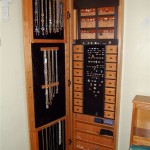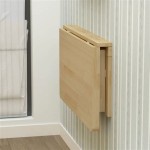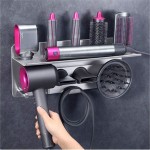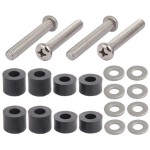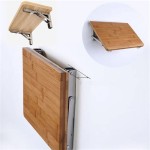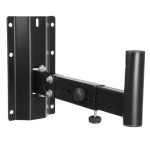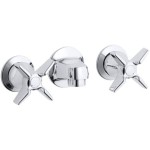Understanding Stud Screws for TV Wall Mounts: A Comprehensive Guide
Mounting a television to a wall is a common approach for optimizing space and enhancing viewing experiences. The structural integrity of the mounting system heavily relies on the fasteners used, particularly when securing the mount to wall studs. Stud screws, specifically designed for this purpose, are engineered to provide a secure and reliable connection between the TV wall mount and the wooden or metal studs within the wall. Understanding the different types, sizes, and installation techniques associated with stud screws is crucial for a safe and successful TV mounting project.
Key Point 1: Types of Stud Screws Used for TV Wall Mounting
Selecting the appropriate type of stud screw is paramount. Several fastener types are frequently employed, each offering distinct characteristics suited for specific applications. The primary consideration is the material of the wall stud—whether it is wood or metal—as this will dictate the type of screw required for a secure hold.
Wood Stud Screws: These screws are specifically designed to penetrate and grip wood fibers effectively. They typically feature a coarse thread pattern that bites deeply into the wood, providing a strong and stable connection. The head of the screw is often designed to countersink flush with the mounting bracket, preventing any obstruction or interference. Common types of wood stud screws include:
- Lag Screws: These are heavy-duty wood screws with a hexagonal head, requiring a wrench or socket for installation. Lag screws are known for their exceptional holding power and are commonly used for securing heavy objects to wood studs. A pilot hole is usually necessary to prevent the wood from splitting.
- Wood Screws (Deck Screws): While technically designed for decking applications, high-quality deck screws can also be suitable for TV wall mounts, especially for lighter televisions. These screws are often coated to resist corrosion and have a self-tapping design, making installation easier. They typically have a flat or bugle head.
- Construction Screws: These are versatile screws used in various construction applications, and some are suitable for TV wall mounts. They often have a self-drilling or self-tapping tip, making installation faster and easier. Look for screws specifically rated for structural applications.
Metal Stud Screws: Metal studs, being made of steel, require specialized screws that can effectively cut threads into the metal without stripping or damaging it. These screws are typically hardened and have a self-drilling or self-tapping tip that eliminates the need for pre-drilling. Important features of metal stud screws include:
- Self-Drilling Screws: These screws have a drill-bit tip that bores through the metal stud, creating a pilot hole and threading the screw in one operation. This type is highly efficient for metal stud applications.
- Self-Tapping Screws: These screws do not have a drill-bit tip but rather a sharp point that initiates the threading process. They rely on the screw's design to cut threads into the metal as it is driven in.
- Pan Head Screws: Often used for metal studs, pan head screws provide a large surface area for clamping the mounting bracket to the stud. They are less likely to pull through the bracket holes compared to other head types.
The choice between wood and metal stud screws depends entirely on the wall stud material. Attempting to use wood screws in metal studs is highly likely to result in failure, as the threads are not designed to grip metal effectively. Conversely, using metal stud screws in wood may not provide the optimal holding power due to the different thread characteristics.
Key Point 2: Determining the Correct Size and Length of Stud Screws
Selecting the proper size and length of stud screws is critical for ensuring a secure and stable TV mount. Insufficient screw length can lead to inadequate holding power, while excessive length can cause interference with wiring or plumbing within the wall. Several factors must be considered when determining the appropriate screw dimensions.
Screw Diameter (Gauge): The diameter of the screw, often referred to as the gauge, affects its strength and holding capacity. For TV wall mounts, a general recommendation is to use screws with a diameter of at least 1/4 inch (6.35 mm) or larger, especially for heavier televisions. The specific gauge required will be dictated by the weight of the TV and the load capacity of the wall mount. Consult the wall mount's instruction manual for recommended screw sizes.
Screw Length: Determining the appropriate screw length involves considering the thickness of the wall mount bracket, the drywall layer, and the desired depth of penetration into the stud. A general rule of thumb is to penetrate at least half the stud's depth for a secure hold. For example, if the stud is 2 inches deep, the screw should penetrate at least 1 inch (25.4 mm) into the stud. The calculation should include these factors:
- Bracket Thickness: Measure the thickness of the mounting bracket at the point where the screws will pass through.
- Drywall Thickness: Standard drywall thickness is typically 1/2 inch (12.7 mm) or 5/8 inch (15.9 mm).
- Desired Stud Penetration: Aim for at least half the stud depth.
Therefore, the total screw length should be the sum of the bracket thickness, drywall thickness, and desired stud penetration. It is generally better to err on the side of slightly longer screws than shorter ones, provided that there is no risk of hitting wiring or plumbing behind the wall. Using a stud finder to identify the precise location of the stud and to check for potential obstructions is essential.
Example Calculation: Assume a bracket thickness of 1/4 inch (6.35 mm), drywall thickness of 1/2 inch (12.7 mm), and a desired stud penetration of 1 inch (25.4 mm). The total screw length required would be 1/4 inch + 1/2 inch + 1 inch = 1 3/4 inches (44.45 mm).
Important Considerations:
- Always consult the TV wall mount's instruction manual for specific screw size and length recommendations.
- Avoid using screws that are too long, as they could potentially damage wiring or plumbing within the wall.
- Ensure that the screws are fully threaded into the stud, providing a secure and stable connection.
Key Point 3: Proper Installation Techniques for Stud Screws
Even with the correct type and size of stud screws, proper installation techniques are crucial for a secure and reliable TV wall mount. Incorrect installation can compromise the integrity of the mount and potentially lead to TV falling. The following steps and considerations are essential for successful installation:
1. Locating Wall Studs: The first step is to accurately locate the wall studs. A stud finder is a valuable tool for this purpose. Electronic stud finders can detect changes in density behind the wall, indicating the presence of a stud. Magnetic stud finders can detect the metal fasteners used to attach the drywall to the studs. It's recommended to verify the stud location by driving a small nail or screw into the wall at suspected locations to confirm that it hits solid wood or metal.
2. Pilot Holes (for Wood Studs): For wood studs, drilling pilot holes is generally recommended, especially when using lag screws. Pilot holes prevent the wood from splitting and make it easier to drive the screws straight and true. The pilot hole diameter should be slightly smaller than the screw's core diameter (the diameter of the screw without the threads). The wall mount instructions will typically provide specific pilot hole size recommendations.
3. Pre-Drilling (for Metal Studs): For metal studs, pre-drilling is generally not required when using self-drilling or self-tapping screws. However, if the metal stud is particularly thick or hard, a pilot hole may be necessary to facilitate screw insertion. Use a drill bit designed for metal and select a size slightly smaller than the screw's diameter.
4. Aligning the Mounting Bracket: Ensure that the mounting bracket is properly aligned with the located studs. Use a level to ensure that the bracket is perfectly horizontal. Misalignment can put undue stress on the mounting system and compromise its stability.
5. Driving the Screws: Use a power drill or impact driver to drive the screws into the studs. Apply steady and consistent pressure to prevent the screw from stripping or camming out. Drive the screws straight and make sure they are fully seated, with the screw head flush with the mounting bracket. Avoid overtightening, as this can damage the stud or strip the screw threads.
6. Testing the Stability: After installing all the screws, test the stability of the mount by gently pulling on it. The mount should feel solid and secure, with no noticeable movement or wobble. If there is any instability, re-tighten the screws or consider adding additional screws for reinforcement. If you are using toggle bolts or other drywall anchors in addition to the stud screws (for example, to secure the mount at the top or bottom between studs), ensure those are installed properly also according to the mount instructions.
7. Safety Precautions: Always wear safety glasses when drilling and driving screws to protect your eyes from debris. Be aware of potential hazards behind the wall, such as electrical wiring and plumbing. If you are unsure about anything, consult a qualified professional for assistance.
By carefully selecting the appropriate type and size of stud screws and following proper installation techniques, you can ensure a secure and stable TV wall mount, providing a safe and enjoyable viewing experience.

Mounting What Screws To Affix Tv Mount Wooden Stud Partition Home Improvement Stack Exchange

Echogear Steel Stud Tv Mount Screws Kit For Mounts Includes 4 Snaptoggle Anchors And A Drill Bit Wal Com

Mounting How Do I Mount Tv Through 3 Layers Of Drywall And Into Studs Home Improvement Stack Exchange

How To Wall Mount A Tv Metal Studs Handyman Startup

Are Wood Screws Strong Enough To Hold A Tv Thediyplan

Installing A Tv Mount Into Metal Studs Kanto Solutions

Wall Mounting A Tv On Metal Stud Bunnings Work Community

Drywall Tv Mount On Wooden Studs What Screws To Use Home Improvement Stack Exchange

Mount It M8 Screws For Samsung Tv 8 Piece Mi M8kit The Home

Steel Stud Tv Mounting Kit For Tilt Low Profile Mounts

